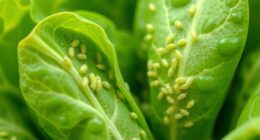To keep a pest monitoring log, establish a consistent inspection schedule and use standardized forms or digital tools to record detailed observations. Document pest species, locations, infestation severity, and environmental conditions accurately. Take photos when needed to support your notes. Regularly reviewing this data helps you identify patterns early and plan targeted treatments, reducing long-term issues. If you want to discover more proven methods and tips, keep exploring further.
Key Takeaways
- Develop standardized forms or checklists to record pest sightings consistently during each inspection.
- Schedule regular inspections (weekly, biweekly, monthly) to ensure thorough and timely data collection.
- Record detailed information such as pest species, location, infestation extent, damage, and environmental conditions.
- Use photographs and digital tools to enhance accuracy and facilitate organized record-keeping.
- Review and analyze pest data regularly to identify patterns and inform targeted management actions.

Keeping a pest monitoring log is essential for effectively managing infestations and preventing future problems. When you maintain a detailed record, you’re better equipped to identify patterns, track pest activity, and respond promptly. One of the key aspects of a successful log is setting and sticking to consistent inspection schedules. By scheduling regular inspections—whether weekly, biweekly, or monthly—you ensure that no signs of pests go unnoticed. This consistency helps you gather reliable data over time, making it easier to spot trends and take action before an infestation becomes unmanageable. Without a clear schedule, your observations might become sporadic, leading to gaps in your data that could delay necessary interventions.
Data accuracy plays a critical role in the effectiveness of your pest monitoring log. When you record your observations, be precise and thorough. Note the exact location of any pest activity, the species involved if possible, and the extent of the problem. Include details such as the size of infestations, damage caused, and any environmental factors that might influence pest behavior. Accurate data allows you to analyze trends more effectively, helping you determine if infestations are worsening, stabilizing, or improving. It also provides valuable information for pest control professionals if you decide to seek expert assistance. The more precise your records, the clearer the picture you’ll have of your pest issues, enabling smarter decision-making.
To improve data accuracy, develop a standardized form or checklist for each inspection. This helps ensure you don’t overlook critical details and that your entries remain consistent over time. Use clear language and, if possible, include photographs to support your written observations. Digital tools or pest management apps can also help you organize your data, set reminders for upcoming inspections, and store information securely. Incorporating uncooked foods and healthy fats can enhance overall caloric intake. Remember, the goal is to create a reliable, easy-to-understand record that reflects the true state of your pest situation. Over time, this detailed log becomes an invaluable resource, guiding your pest management strategies and helping you refine your inspection schedules for maximum effectiveness.
Maintaining a pest monitoring log isn’t just about recording what you find—it’s about creating a structured system that emphasizes regularity and accuracy. By establishing consistent inspection schedules and ensuring data accuracy, you maximize the usefulness of your records. Over time, this disciplined approach helps you catch problems early, implement targeted treatments, and ultimately keep your environment pest-free. When you treat your pest log seriously, you take control of the situation, reducing the risk of severe infestations and saving yourself time, money, and stress in the long run.
Frequently Asked Questions
What Materials Are Best for Pest Monitoring Logs?
You should use durable, weather-resistant materials like laminated paper or plastic for pest monitoring logs. These materials help with log organization and guarantee your records stay intact during inspections. Use clear labels for pest identification and specific locations to make tracking easier. Keep your log in a protected spot, and update it regularly to spot trends and manage pests effectively. This way, your pest monitoring is accurate and organized.
How Often Should I Review My Pest Log?
Think of your pest log as a garden needing regular tending. You should review your record review frequency at least once a month to catch trends early. Keep your log update schedule consistent, updating it whenever you spot new signs of pests or changes in activity. This proactive approach helps you stay ahead of infestations, ensuring your pest management remains effective and your property stays protected.
Can Digital Tools Replace Paper Logs Effectively?
Digital tools can replace paper logs effectively, especially with software advantages like easy updates, quick data access, and automated alerts. You benefit from real-time monitoring and seamless data sharing, making pest management more efficient. While paper logs are simple and tangible, digital vs paper options offer greater flexibility and organization. If you prefer convenience and accuracy, adopting digital pest monitoring software is a smart move for your pest control needs.
What Specific Pests Should I Monitor Regularly?
You should regularly monitor pests like ants, rodents, cockroaches, termites, and bed bugs, as they can cause significant issues. Focus on pest identification to accurately detect each pest type, and adjust your monitoring frequency based on the risk level—more often for high-risk pests. Keeping a detailed log helps you track patterns and respond quickly, ensuring effective pest management and preventing infestations.
How Do I Handle Missing or Incomplete Entries?
You might find it frustrating when you encounter missing or incomplete entries, but don’t let it derail your process. To handle this, focus on record keeping consistency by reviewing your logs regularly, and fill in gaps with any available details or notes. Troubleshooting incomplete data becomes easier when you stay diligent, ensuring your pest monitoring log remains accurate. This way, you’re always prepared to respond swiftly to pest issues, even when entries are imperfect.
Conclusion
By keeping a pest monitoring log, you’re turning your space into a fortress of knowledge and control. Think of it as your secret weapon, revealing patterns and helping you stay one step ahead. Remember, a well-maintained log isn’t just paper; it’s your shield against surprises. So, stay vigilant and organized—because in the battle against pests, knowledge truly is power. Keep track, stay sharp, and let your log be the lighthouse guiding you through the storm.









